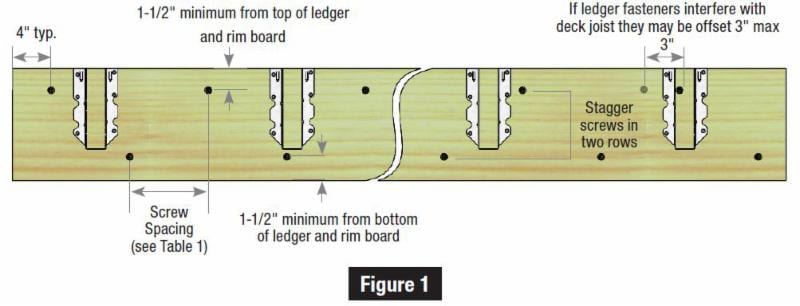Image via “A reporter’s near-deck experience” by Jill Ryan. Click to read the whole article.
On, September 11th 2016, a deck ledger failed and a pair of third floor decks collapsed at a party near Trinity College in Connecticut. Approximately 30 people were injured.
The third floor deck fell onto the second floor deck, which then collapsed onto the first floor deck. Both decks had people on them, as well as the top deck.
Nobody was hurt bad enough that they couldn’t get up and walk around, but there was a head injury and a broken arm. Considering those on the first floor had two decks worth of people fall on their head, they’re lucky.
This isn’t an isolated incident. On August 26th, 2016, another deck at another college party collapsed. This time in Brookhaven, New York.
While college parties are known for being erratic, collapsing decks seems a bit too far.
According to Arthur Gerhauser, chief building inspector of the Town of Brookhaven, the failure of the deck was “at the ledger board, the connection of that ledger board to the house.”
While these decks may have been old and may have been built to outdated codes, it’s important to know how to attach a deck ledger to rim board according to current codes. You wouldn’t want one of your buildings to be in the news for having a deck that collapsed on a college student.
You’ll need…

MiTek has a series of wood screws, the USP WS series, that you can use to fasten deck ledgers to the rim board (band / rim joist) to ensure you’re meeting the residential building code’s connection requirements. The 2015 IRC suggests, in Table R507.2, to use lag screws, however the WS-HDG screws may replace them when installed as directed here.
Common lengths for deck ledger application are WS35-HDG at 3.5 inches and WS5-HDG at 5 inches. Make sure to purchase WS screws with “-HDG” suffix, as they have a hot dipped galvanized coating suitable for exterior use.
Deck Ledger Installation:
 As previously stated, the screw lengths you’ll likely need are WS35-HDG (3.5 inches) and/or WS5-HDG (5 inches).
As previously stated, the screw lengths you’ll likely need are WS35-HDG (3.5 inches) and/or WS5-HDG (5 inches).- When selecting screw length, compare the threads. They should have full engagement with the rim board. The tip of the screw should visibly protrude beyond the inside face of the rim board member.
- Once you’ve selected the proper screw length, drive the screw through the ledger, sheathing, and rim board joist. Use a high torque variable speed drill.
- When driving the screw, the head should be firm and flush with the surface of the deck ledger. Be sure not to overdrive.
- Table 1 and Figure 1 below will show you the edge, end distances, and spacing that you’ll need. Repeat the above steps for each necessary screw.
The structural wood screws you’re looking for can be found here.
MiTek Builder Products, USP Connectors, and Hardy Frame are corporate members of the American Institute of Building Design (AIBD). To find a representative near you, contact Lori Zito at lzito@mii.com.
Updated: 12/30/2022
Correctly attaching the deck’s ledger board to the supporting structure is an important part of the deck’s structural integrity. But more can be done to protect the ledger and joists from moisture, thus lengthening the deck’s life.
One of the images above illustrates the use of flashing to protect the deck ledger, but we failed to point it out, as well as its importance while composing the post.
According to our friends at the Journal of Light Construction magazine, deck failure happens at the connection point to the home. Either the deck is not connected properly, or there is rot on the wood – most commonly caused by exposure to water over time.
The article says the biggest cause of deck failure is moisture getting on or into lumber. The use of younger trees not having closer growth rings makes this an even bigger issue. Moisture will be able to penetrate even easier.
Regarding protecting the ledger board, there are two main approaches – metal flashing and flashing tape.

The biggest advantages of metal are that it’s inexpensive and can be installed in any weather. It requires bending, which is time-consuming and can be dangerous to handle due to its sharp edges. Metal also requires nails or screws for installation, which creates opportunities for moisture penetration. While it diverts water away, it doesn’t seal water out. In fact, many counties no longer allow metal flashing because it is so prone to leaks.
Flashing tape is better for waterproofing. It creates a tight seal on boards and around hardware. Some tapes can be difficult to control due to their stickiness and, historically, have not come in an optimal size for ledger-specific applications.
But solutions are on the way. Read the full article…





Thanks for the very well-detailed blog, I used to attach my deck ledger this is so helpful.